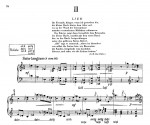Title
There comes a point in every student’s career when you return to a piece you’ve worked on before. It’s an essential part of artistic refinement, but the implications can be complex. There’s no way to approach the piece with the same freshness as you did originally. You start to remember the last performance, and the one before that. After a while, they start to blend into one cumulative experience, encompassing all the joys and frustrations you’ve felt in playing them. One might say it’s simply nostalgia or even navel-gazing, but I’m not sure that’s the right way to look at it. Why do we return to our favorite books, for instance? Is it to seek joy, comfort, or maybe just reassurance? Was the reading really one you want to relive, or even idealize for its ephemerality? Complicated as these sensations are, memory and reacquaintance are things we deal with as humans, not just as musicians. It’s not a choice. It’s a reality of life.
Body
Here at Juilliard, I’ve recently returned to two works I’ve had with me for 10 years—one on the harpsichord, one on the harp, the first by Bach, the second by Paul Hindemith. These pieces evoke a certain obsessive quality in me while occupying different places in my life due to their varied histories under my fingers. Whenever I play them, I relive each encounter with them, every lesson, every performance, and every long conversation I’ve had about them, from nights in bars to bedtime pillow talk. I admit a certain difficulty arises for me in talking about these pieces, both on an emotional and cerebral level, as their density in compositional structure could fill essays and dissertations, and not just hours in solitary practice rooms.
The Allemande from Bach’s Fourth Partita is less of a dance movement and more of a run-on sentence. The right hand wanders aimlessly while the left hand brings it back down to earth. It’s not dissimilar to reading Emerson or Proust, two authors so filled with twisted and interconnected ideas that the reader is grateful for the constraints of modern grammar. There’s no obvious direction in the work, which soliloquizes for 10 and a half minutes and passes through nearly every tonality possible before somehow coming full circle to D major. On the flip side, the Lied from Hindemith’s Sonata for Harp is a work with near-impenetrable formal boundaries. The melody of the right hand is a setting of a poem so strict that the words can be literally laid under notes as if it were an art song by Wolf or Schumann. Devoid of counterpoint, the left hand simply mirrors the right, deafening the listener with austerity.
Both are frustrating to work on, as they’re slow yet technically intricate. The notes don’t fly by, but suspend in the air as you wallow through harmonies. With Bach, the struggle is to find a way to rein it all in and infer some sense into the chaos of right hand’s figurations. There’s no rhetoric or discernible affect. It almost becomes just white noise. What is Bach getting at? What is he trying to say? With the Hindemith, on the other hand, there’s no mistaking the message. Composed just after his exile from Nazi Germany in 1939, Hindemith’s piece is set to Ludwig Hölty’s poem about a dying bard eulogizing the fate of children in his local churchyard, and it reflects Hindemith’s depressive state about imminent outbreak of the Second World War.
I returned to the Allemande for the first time in 10 years this week. At age 14, I had the privilege of playing it in a master class for pianist Peter Takács. It wasn’t long after that I ceased my formal studies at the piano in order to spend more time on the organ, but the Allemande stayed with me privately, permanently ingrained in my muscle memory. I haven’t had occasion to work on it since, but the opportunity to play it for one of my musical heroes felt like an appropriate occasion for revival. I’ve played Hindemith’s Sonata in several master classes and studied it with five teachers, including my own mother. I’ve been given so many fingerings, interpretations, and tempo schemes that I finally had to purchase a fresh score last week to clear the air. I suppose it’s because I’ve never really stopped working on it, continuously going down a rabbit hole, attempting to bring the poem’s tragedy off the page.
In my lessons this week with Richard Egarr and Nancy Allen, I relived my past experiences with the pieces as usual, but this time with a firm sense of closure. At the harpsichord, Professor Egarr encouraged me not to rein anything in, but to revel in the complexity, the dissonance, the linguistic soupiness of the Allemande.
Sitting at the harp bench, Professor Allen encouraged me to see the Lied through Hindemith’s eyes, not as a work of intense emotion but as the product of an artist using neoclassicism to build a wall against his own pain. Smiles and handshakes from my professors helped to lighten the mood and even lower the stakes of my obsession. For the first time, I felt I had gotten to the bottom of what was really on the page with these pieces that have lived with me for so long. In the end, the sensation was one of passing from study into artistry, from performance to communication. What can I say? It’s been a typical week here at Juilliard.






